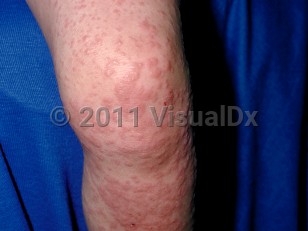Gianotti-Crosti syndrome in Child
Alerts and Notices
Important News & Links
Synopsis

Gianotti-Crosti syndrome (papular acrodermatitis of childhood, papulovesicular acrolated syndrome) is a self-limiting dermatosis likely triggered by viral infection.
The eruption of Gianotti-Crosti syndrome typically lasts 3-4 weeks and is usually seen in preschool children but can be seen in children aged up to 13 years with rare case reports in adults. It is most commonly diagnosed in children aged 6 months to 14 years. The lesions can last up to 8 weeks before resolving spontaneously. A 2016 study found that children with atopic dermatitis or other manifestations of atopy were at greater risk for Gianotti-Crosti.
Agents thought to be responsible for the typical eruption include hepatitis B virus, hepatitis A and C viruses, cytomegalovirus (CMV), Epstein-Barr virus (EBV), enteroviruses, rotavirus, respiratory syncytial virus, parvovirus B19, vaccinia virus, rubella virus, human immunodeficiency virus (HIV)-1, and parainfluenza virus. The syndrome has also been observed following immunizations against poliovirus, diphtheria, pertussis, Japanese encephalitis, influenza, and hepatitis B virus and measles (together). The clinical features of the syndrome are identical, independent of the triggering agent.
With widespread immunization, most cases of Gianotti-Crosti syndrome seen in the United States, Canada, Europe, and India are not associated with hepatitis B virus infection. EBV is by far the most common cause in the United States.
The eruption of Gianotti-Crosti syndrome typically lasts 3-4 weeks and is usually seen in preschool children but can be seen in children aged up to 13 years with rare case reports in adults. It is most commonly diagnosed in children aged 6 months to 14 years. The lesions can last up to 8 weeks before resolving spontaneously. A 2016 study found that children with atopic dermatitis or other manifestations of atopy were at greater risk for Gianotti-Crosti.
Agents thought to be responsible for the typical eruption include hepatitis B virus, hepatitis A and C viruses, cytomegalovirus (CMV), Epstein-Barr virus (EBV), enteroviruses, rotavirus, respiratory syncytial virus, parvovirus B19, vaccinia virus, rubella virus, human immunodeficiency virus (HIV)-1, and parainfluenza virus. The syndrome has also been observed following immunizations against poliovirus, diphtheria, pertussis, Japanese encephalitis, influenza, and hepatitis B virus and measles (together). The clinical features of the syndrome are identical, independent of the triggering agent.
With widespread immunization, most cases of Gianotti-Crosti syndrome seen in the United States, Canada, Europe, and India are not associated with hepatitis B virus infection. EBV is by far the most common cause in the United States.
Codes
ICD10CM:
L44.4 – Infantile papular acrodermatitis [Gianotti-Crosti]
SNOMEDCT:
82721003 – Gianotti-Crosti syndrome
L44.4 – Infantile papular acrodermatitis [Gianotti-Crosti]
SNOMEDCT:
82721003 – Gianotti-Crosti syndrome
Look For
Subscription Required
Diagnostic Pearls
Subscription Required
Differential Diagnosis & Pitfalls

To perform a comparison, select diagnoses from the classic differential
Subscription Required
Best Tests
Subscription Required
Management Pearls
Subscription Required
Therapy
Subscription Required
References
Subscription Required
Last Reviewed:03/15/2017
Last Updated:03/21/2023
Last Updated:03/21/2023

